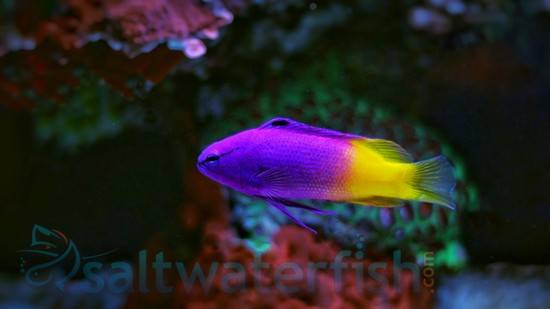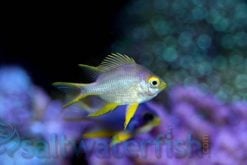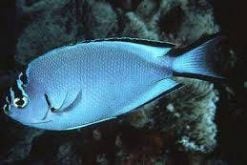Royal Gramma (Gramma loreto)
Quick Stats:
- Care Level: Moderate
- Temperament: Semi-aggressive
- Diet: Carnivore
- Reef Safe: Yes
- Minimum Tank Size: 30 gallons
- Max Size: 3 inches
- Water Parameters:
- pH: 8.1-8.4
- Temperature: 72-78°F
- Salinity: 1.020-1.025
- Ammonia, Nitrite, Nitrate: 0
Royal Gramma (Gramma loreto) – Saltwater Aquarium Guide:
The Royal Gramma, also known as Gramma loreto, is a colorful and popular fish species for saltwater aquariums. In this comprehensive guide, we will cover various aspects of keeping the Royal Gramma in your aquarium.
Habitat:
The Royal Gramma is native to the Caribbean Sea, specifically around the reefs of the Dominican Republic, Haiti, and the Bahamas. It is commonly found among coral formations and rocky crevices.
Reef Safe:
The Royal Gramma is considered reef safe, making it a suitable choice for reef aquariums. It rarely bothers corals or other invertebrates.
Size:
The Royal Gramma typically grows up to 3 inches in length, making it a relatively small fish for aquariums. Its small size allows it to fit well in smaller tanks.
Temperament:
The Royal Gramma has a semi-aggressive temperament. While it generally gets along with other peaceful fish, it may exhibit territorial behavior towards similar-looking fish or other small fish.
Sexual Dimorphism:
There is no discernible difference in appearance between male and female Royal Grammas. Both sexes share the same vibrant purple and yellow coloration.
Lifespan:
The Royal Gramma can live for up to 5 years with proper care and a suitable environment. Good water quality and a balanced diet contribute to their longevity.
Diet in Aquariums:
The Royal Gramma is a carnivorous species that feeds primarily on small crustaceans and zooplankton. In an aquarium, it can be fed a varied diet consisting of high-quality frozen or live foods, such as brine shrimp, mysis shrimp, and small marine pellets.
Aquascaping Recommendations:
Providing plenty of hiding places and caves is essential for the Royal Gramma. They enjoy darting in and out of rock formations and crevices. Live rock with ample hiding spots and caves mimics their natural habitat and enhances their overall well-being.
Captive Bred Availability:
The Royal Gramma is available as captive-bred specimens, which are generally hardier and better acclimated to aquarium life. Captive-bred fish also help conserve wild populations and reduce the impact of collection on natural habitats.
Compatibility with Other Fish, Invertebrates, or Corals:
The Royal Gramma is generally compatible with a variety of tankmates. However, caution should be exercised when keeping them with other basslets or similar-looking species, as territorial aggression may occur. Here are 5 specific tankmates that can be good choices:
- Pajama Cardinalfish: Peaceful and colorful, they make great tankmates and add visual interest.
- Firefish Goby: Their vibrant colors and peaceful nature complement the Royal Gramma well.
- Cleaner Shrimp: They help maintain the tank’s cleanliness and also serve as an interesting addition.
- Peppermint Shrimp: Known for their ability to eat unwanted pests like Aiptasia anemones.
- Finger Leather Coral: This coral species can coexist peacefully with the Royal Gramma while adding a beautiful aesthetic to the tank.
Why people should buy from Reefs4Less.com: Reefs4Less.com offers a wide selection of high-quality marine livestock and supplies. With their commitment to excellent customer service, competitive pricing, and expert advice, they ensure a positive and trustworthy shopping experience for saltwater aquarium enthusiasts.
Popular Questions and Answers:
1. Can the Royal Gramma be kept in a small tank?
While the Royal Gramma is relatively small in size, it still requires a minimum tank size of 30 gallons to provide adequate swimming space and suitable habitat.
2. Will the Royal Gramma eat corals or other invertebrates?
No, the Royal Gramma is considered reef safe and rarely bothers corals or other invertebrates.
3. How often should the Royal Gramma be fed?
It is recommended to feed the Royal Gramma twice a day, offering a varied diet of frozen or live foods. Adjust the quantity based on their appetite and avoid overfeeding.
4. Can the Royal Gramma be kept with aggressive fish?
While the Royal Gramma can coexist with some semi-aggressive fish, it is generally best to avoid housing them with highly aggressive species to prevent territorial conflicts and stress.
5. Are there any specific water parameters to maintain for the Royal Gramma?
For optimal health, maintain stable water parameters with a pH range of 8.1-8.4, temperature between 72-78°F, salinity of 1.020-1.025, and zero levels of ammonia, nitrite, and nitrate.
| Size | 1 – 2 inches |
|---|




Reviews
There are no reviews yet.